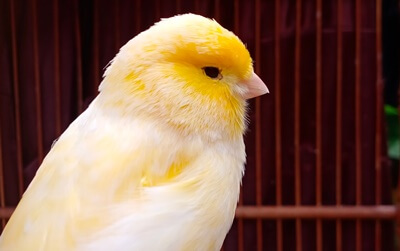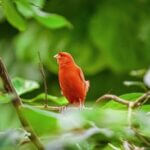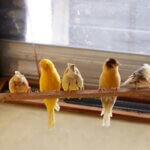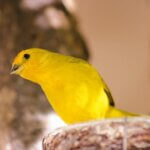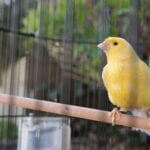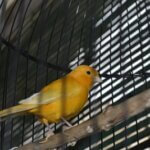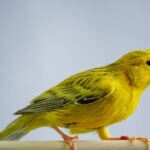As canaries age, you may notice a range of physical changes taking place.
The scales on a canary’s feet and the shape of its genitals will modify. Also, according to Behavioral and Neurological Biology, the nature and volume of a male canary’s song can alter with age.
The color and texture of a canary’s feathers will change. While most people think of the characteristic bright yellow plumage, canaries can also be white, red, orange, brown, pastel, grey, and blue.
The initial color of a canary’s feathers and whether the feathers change color at any time are impacted by its dietary regimen and genetics. Yellow, orange, and red canaries have unique genetic factors that enable them to produce feathers in bright, lustrous colors.
A canary’s feathers can change color, but only in decreasing intensity. For example, a red-factor canary’s feathers can fade to yellow, and a yellow canary’s feathers can turn white. However, a genetically white or albino canary won’t suddenly become yellow or red.
Fading or changes to a canary’s plumage usually signify a nutritional deficiency. However, a change in the color of a canary’s feathers is unlikely to result from sickness unless there’s a change in the overall condition of the feathers (abnormal growth, dullness, bleeding, or baldness).
Some color changes are entirely benign, while others require prompt veterinary attention.
Do Baby Canaries Change Color?
The color of a canary’s feathers may increase in intensity as it ages. However, the red-factor canary is known for changing color entirely.
Developed in the 1900s, red-factor canaries are the result of cross-breeding the Venezuelan black-hooded red siskin and the traditional yellow canary.
When first hatched, the chicks can range in color from pale yellow to peach or orange. The iconic bright red plumage develops as the canaries mature.
However, if you want to maintain this bright-red color, you’ll need to carefully plan your canary’s diet and ensure it lives in optimal conditions.
Any canary kept in less-than-ideal conditions may experience:
- Sickness
- Weight fluctuation
- Unhappiness
- A loss of desire to sing
If so, red-factor canaries will lose their vibrant coloring more quickly and noticeably.
Why Is My Red-Factor Canary Turning Yellow?
The red-factor canary’s coloring has to be actively maintained for peak vibrancy. The intensity of the red coloring will largely depend on diet.
Assess its food if a red-factor canary is starting to turn yellow or orange. The right variety, balance, and food quality are required for optimal coloration.
To maintain the color and condition of a red-factor canary’s plumage, provide food rich in beta-carotene and canthaxanthin. This is most important before and during molting when new feathers are formed.
A red-factor canary will turn yellow after molting if you don’t undertake color-feeding. However, you can color-feed at the next molting cycle to re-create the red coloration.
You can purchase color-feeding supplements for red-factor canaries, but these aren’t necessarily healthy for birds. According to BioRXiv, studies into the metabolic capacity of red-factor canaries indicate that evidence is currently limited.
For this reason, it’s often safer to feed the canary foods rich in beta-carotene and other color-enhancing nutrients. Examples of such foods include:
- Dark, leafy greens, such as spinach and kale
- Sweet potatoes
- Beets
- Cherries
- Grated carrots
- Tomatoes
- Seed mixes
- Butternut squash
Why Is My Orange Canary Turning Yellow?
Although they’re called red-factor canaries, this distinctive bird can have orange feathers.
Furthermore, all canaries get their coloring from carotenoids to an extent. If your canary is usually a deep or vibrant orange color, and its feathers are turning yellow, consider if it’s due to its molt or diet.
If a canary’s in the process of molting, the gradual changing of its plumage from orange to yellow would suggest that you’re not giving it enough foods rich in beta carotene.
You may still be able to reverse this if you provide foods rich in color-promoting nutrients. It’s important to remember that the change in feather color will remain until the next molt.
So, don’t worry if you change a canary’s diet and see no return to its previous orange or reddish color for months. New feathers must form and grow in before you see anything noticeable.
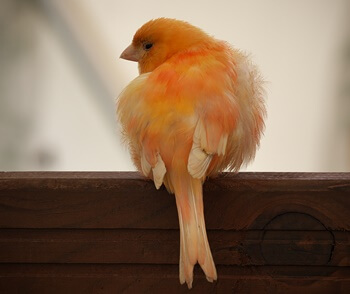
Why Is My Yellow Canary Turning White?
A certain level of fading and dullness may accompany the natural aging process.
So, if your canary isn’t showing any other signs of physical deterioration but is over the age of 7, it’s likely that its whitening feathers are associated with aging.
Yellow canaries are more resistant to color loss or changes than red-factor canaries. However, this doesn’t mean they’re entirely immune to it.
If your canary has a diet too low in beta-carotene, canthaxanthin, and other color-promoting nutrients, its feathers may become pale or lose color entirely. A diet that lacks any noticeable amount of pigment-creating nutrients will lead to your canary turning white over time.
The most effective way to address color loss in plumage is to provide a nutritious diet.
However, if your canary seems to be losing color altogether or the change in diet makes no difference to color changes, there may be underlying issues that require your consideration.
Is My Whitening Canary Sick?
Certain gastrointestinal conditions, such as proventricular dilatation disease (or PDD), can prevent the optimal absorption of nutrients from food.
Otherwise known as proventricular dilatation syndrome and previously called macaw wasting disease/syndrome, PDD is a solely avian condition. This is a chronic ailment characterized by vomiting, the inability to digest food, general physical weakness, and organ failure.
If you identify color loss or change in a canary’s plumage and are certain you’re providing the right amount of quality foods, you need to explore other signs of illness.
The most common signs of sickness include:
- Thinning or matted feathers
- Bald spots
- Pulling feathers
- Weight loss
- Lumps or swelling
- Bloated chest
- Lack of appetite
If you notice these signs in tandem with color changes or pigment loss from the feathers, it’s likely sick or injured. Canaries have fast metabolisms, so an undiagnosed health problem quickly progresses.
Isolate the sick canary from its cage mates to avoid spreading the infection. If this proves impossible and the cage is portable, you can use the cage to transport any canaries to a different living space.

